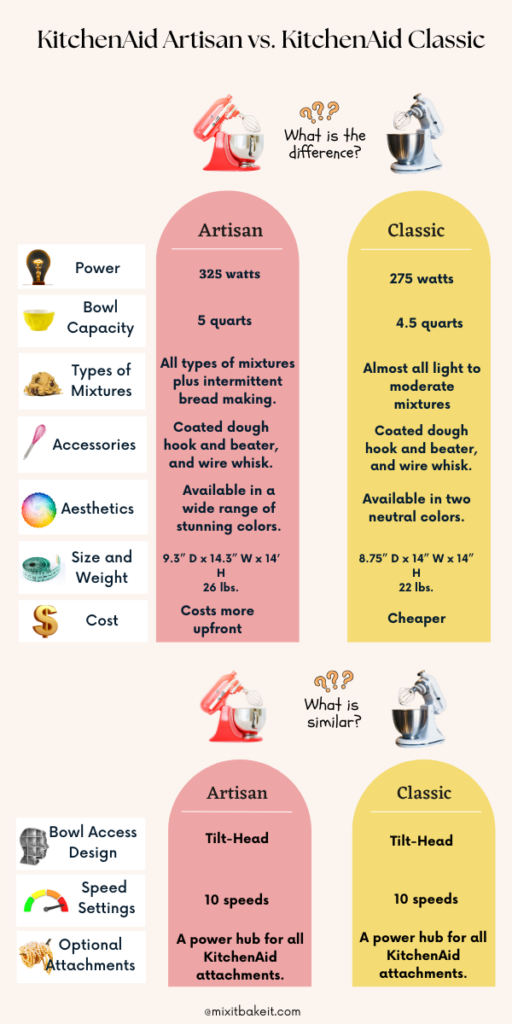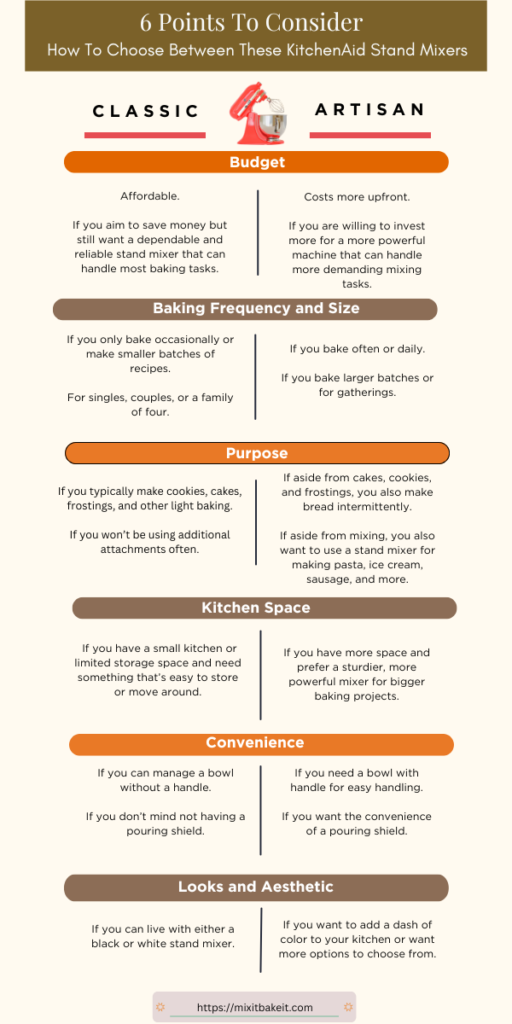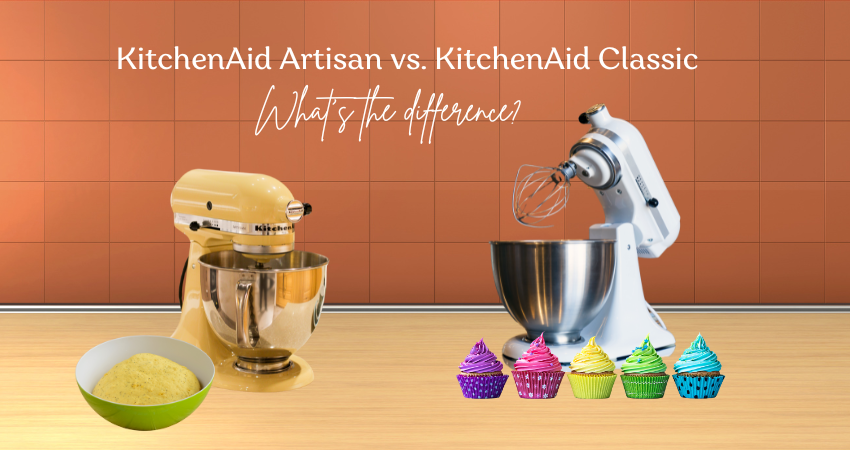Notice: I receive compensation if you buy something through affiliate links on this post. This does not change the price you would pay.
Can’t seem to wrap your head around what sets the KitchenAid Artisan vs. KitchenAid Classic mixers apart?
I, too, had a ton of questions when I started looking at these two very close stand mixers from KitchenAid.
Let me tell you, it’s difficult to tell them apart unless you dig deeper, and that’s what I did.
On this page, I will explain why and how they differ and what makes them alike, identify the tasks each model is suited for, and describe the types of bakers each one matches.
At the end of this article, you’ll know which of these KitchenAid mixers is for you.
Let’s dive in.
Table of Contents
What Is the Difference Between Kitchenaid Classic and Artisan Mixers?
There are seven (7) key differences between the Artisan and the Classic:
- Power
- Bowl Capacity
- Mixing Performance
- Attachments
- Dimensions and Storage
- Design and Aesthetics
- Price
We shall discuss each in detail so you can gauge which mixer is apt for your baking needs.

Wattage: Powering Up Your Baking
Most people instinctively assess a stand mixer by its motor’s wattage, and for good reason. Motor power determines what mixing tasks it can tackle.
Power in watts is one of the key differences between the KitchenAid Artisan and KitchenAid Classic.
The Artisan comes with a 325-watt motor, and the Classic has a 275-watt motor.
So, what benefit does a 50-watt power difference bring?
Short answer: bread and volume.
Is that power difference significant?
It is.
It makes the KitchenAid Artisan capable of tackling two loaves of bread at a time, albeit intermittently. In contrast, the 250-watt KitchenAid Classic mixer is not meant for bread making, although it can occasionally handle one loaf at a time.
Both models work well with all other mixtures, such as cake batters, cookies, frostings, egg whites, and creams. However, the KitchenAid KSM150P Artisan can handle slightly bigger quantities, such as several batches of cookies at a time.
Both models have direct-drive motors, which utilize electric power more efficiently. Hence, they require less current than belt-driven motors to achieve the same level of performance.
So, we know the tasks these KitchenAid mixers can handle, but how much can they hold?
Let’s discuss that in the next section.
Bowl Capacity and Design
The KitchenAid Artisan KSMP150 mixer’s bowl holds 5 quarts, slightly more than the Classic KitchenAid’s 4.5-quart bowl.
The KitchenAid Classic is an entry-level stand mixer for beginners or homemakers who bake for a family of three. Its 4.5-quart bowl can hold two box cake mixes, two custom batches of cake recipes, or a double batch of icing.
The Artisan series can accommodate three cake recipes, but it will be almost full, and scraping the content will be difficult and messy. If you have to add ingredients, only two recipes of doctored cake mixes will fit.
Here is another advantage of the Artisan’s bowl: a handle. It makes carrying the bowl and pouring mixtures easier, especially if you have weak hands or arms. It’s easier to keep the bowl steady and not swinging.
KitchenAid Artisan vs KitchenAid Classic: Mixing Performance
Both models have a planetary mixing action and 59 touchpoints around the bowl.
Here’s how it works:
The beater, dough hook, or whisk spins on its axis as it moves around and touches 59 points on the bowl in one rotation. Such a mixing mechanism results in even and thorough mixing.
But, mixing action aside, the Artisan series is better for denser mixtures and larger quantities because it has more wattage.
Accessories and Attachments
The KitchenAid Classic and Artisan include the standard accessories (coated flat beater, coated dough hook, and 6-wire whip).
However, the Artisan Ksmp150 also includes a pouring shield. Do you need it?
It’s not a necessity for a KitchenAid stand mixer to work. But it provides convenience.
Will it matter? It depends on personal preference.
I prefer having one. Let me tell you, I’ve had several episodes of flour flying smack into my face, kitchen walls, and counter.
With a pouring shield, I don’t have to stop the mixer to add ingredients because it prevents those splatters and makes cleaning much easier.
The Classic does not have a pouring shield, but you can purchase one separately if you find it useful.
All KitchenAid optional attachments for stand mixers are compatible with the Artisan and the Classic.
Dimensions and Storage
Before buying a stand mixer, consider how and where it will sit in your kitchen.
Will you store it in a cabinet? Do you have to pull it out and move it around?
Knowing any stand mixer’s size, dimension, and weight is essential before you take one home.
Here are the dimensions and weights of the Artisan and Classic KitchenAid:
- KitchenAid Classic:
- 8.75” D x 14” W x 14” H
- 22 lbs
- Artisan Series:
- 9.3” D x 14.3” W x 14’ H
- 26 lbs
As you can see, the Artisan is slightly bigger and heavier than the Classic.
If you will move your stand mixer around or take it out from a cabinet, have a tight kitchen, or have weak arms, the Classic might be a better option.
Design and Aesthetics: Why Style Matters
Imagine how your kitchen would look if you had a red air fryer and a green blender on your countertop against a bluish backsplash. That would be a visual disaster.
That is why choosing an appliance that suits your style, blends with, and enhances your kitchen’s aesthetic is important.
The KitchenAid Artisan trumps the Classic in terms of looks. It comes in many stunning colors that will enliven your kitchen space. If your kitchen’s overall look is neutral, adding a pop of color can brighten it. If you want to tone down a colorful kitchen, the Artisan has gorgeous neutral shades, too.
Neutral doesn’t have to be black and white only. Unfortunately, the Classic KitchenAid mixer only comes in those colors.
Let’s talk money next.
Price and Value of KitchenAid Artisan vs Classic
Let me guess. You already know which KitchenAid model is cheaper.
The Classic model costs less because it has less power, capacity, and accessories. However, this does not mean that it is less reliable. It is an affordable and dependable mixer for lighter mixing jobs and small quantities.
Check the price of the KitchenAid Classic stand mixer.
Although the KitchenAid Artisan is more expensive, its higher power and capacity allow it to do more. Think larger quantities and demanding tasks like bread.
The bundled pouring shield also makes adding ingredients more convenient and cleaning easier.
Plus, you can get a color that perfectly matches your style and kitchen’s theme.
Check the price of the Artisan KitchenAid mixer.
Classic KitchenAid vs Artisan : Common Features
These popular KitchenAid stand mixers have different key features and are similar in other aspects. Here’s where they’re the same:
- Tilt-Head Design
- Speed Settings and Controls
- Optional Attachments
- Ease of use and Cleaning
Let’s discuss those common areas in detail.
Tilt-Head Design
You probably have heard or read about a tilt-head stand mixer, but if you haven’t, here’s what to know about it:
When a tilt-head mixer is in operating mode, its motor head is in the down position. As such, there is not enough clearance between the bowl and the mixer head to access anything in the bowl. Hence, the head must be tilted to attach or detach accessories or mix ingredients by hand.
The Artisan and Classic’s heads are easy to raise and lower. Hinges connect them to the mixer’s stand, and a locking pin secures them to prevent bobbing.
Check this post for an in-depth discussion of tilt-head stand mixers.
Speed Settings and Controls
These KitchenAid stand mixers have ten speeds. Speed settings and controls are located on the side of the mixer head. A speed lever slides to the desired speed setting.
Now, only speeds STIR, 2, 4, 6, 8, and 10 are shown. However, you can locate speed settings 3, 5, 7, and 9 between the even-numbered speeds.
The odd-numbered speeds offer finer speed controls.
Are ten speeds enough in a stand mixer?
Yes. These KitchenAid stand mixers can perform all mixing tasks, from slow blending, kneading dough, creaming butter, and whipping fluffy meringues.
Optional Attachments: Reinventing KitchenAid Stand Mixers
You can do more than mixing, kneading, and whipping with KitchenAid Classic and Artisan.
With KitchenAid’s optional attachments, you don’t have to buy separate appliances, saving you money.
And you don’t have to worry about fitting several machines into your kitchen space.
All attachments fit any KitchenAid stand mixer.
Here’s the list of KitchenAid’s stand mixer attachments:
- Pasta maker
- Pasta roller and cutter
- Ice cream maker
- Sausage stuffer
- Slicer/shredder
- Food grinder
- Citrus Juicer
- Meat tenderizer
- Spiralizer
- Food processor
- Vegetable sheet cutter
- Ice shaver
- Sifter plus scale
- Grain mill
Ease Of Use and Cleaning
How easy is it to operate the Classic and Artisan?
KitchenAid tilt-head stand mixers are simple to use. You don’t have to master anything.
Refer to this video for instructions on preparing and using the Artisan or Classic mixers.
What about cleaning? It’s easy, too.
You can wipe the stand mixer with a damp cloth to remove debris that may have deposited on the body and accessory shaft.
The bowl, coated beater, and coated dough hook are dishwasher safe; the wire whisk is not. Wash the whisk with soap and water. Dry all accessories before storing them.
Pros and Cons
Let’s summarize the pros and cons of the KitchenAid Classic and KitchenAid Artisan stand mixers.
Pros and Cons of KitchenAid Classic
Pros:
- Affordable
- Compact, easy to store and move around.
- Reliable for most baking tasks.
- Easy access to bowl with tilt-head design.
- User-friendly interface.
- Easy to clean.
Cons:
- Its less powerful motor can struggle with dense mixtures.
- Smaller bowl.
- The bowl has no handle.
- No pouring shield.
- Available in only two color options
Pros and Cons of KitchenAid Artisan
Pros:
- Its more powerful motor can handle more challenging mixing tasks like kneading dough.
- A bigger bowl accommodates bigger volumes in a batch.
- A bowl with a handle makes it easier to carry.
- Reliable performance for almost all mixing jobs
- Able to knead dough on an intermittent basis.
- Available in an array of stunning colors to match any style and kitchen theme.
- Easy access to bowl with tilt-head design
- User-friendly interface
- Easy to clean
- Includes a pouring shield
Cons:
- More expensive.
- Larger and heavier, which makes it difficult to move around.
We have discussed the details. The next section puts everything together.
KitchenAid Mixer Artisan vs Classic: Which One Should You Pick?
Now that you know the differences and similarities between these KitchenAid stand mixers, the next step is to match them with your situation.
These are the points you should consider:
- Your budget
- Your baking habits
- Your purpose for a stand mixer
- Kitchen space
This infographic will guide your decision-making process:

The Stand Mixer That Fits Your Baking Style
The haze that clouds two very close KitchenAid stand mixers has now been lifted.
You know what sets the KitchenAid Artisan and the KitchenAid Classic apart, their similarities, and what baking tasks they can do.
But understanding features and capabilities is only part of the process; it also involves identifying the type of baker you are and your circumstances.
Having gone through the process, you can now match your baking needs with the right KitchenAid stand mixer.
It’s time to elevate your baking, delight in making more treats, and enjoy the convenience of having a stand mixer.
Go ahead and bring home your perfect kitchen buddy.




The author did an excellent job describing both mixers and their functions. Every question is anticipated and answered. Great information and exactly what I sought.
Hi Keith,
I’m happy to be of help. Thank you for sharing your experience.
Cheers,
Rose